Cosmic Context of Greek Philosophy (1)
It seems to me that none of what the various early philosophers were saying, doing, or writing can be easily comprehended if one does not have a good grasp of the history of the time. And that history is not just social and political, it is also environmental. Even with such knowledge, you are handicapped because the Christian scribes who took charge of literature for centuries made sure that their story was as consistent as they could make it. One has to pay attention to everything in order to adduce anything sensible about historical matters.
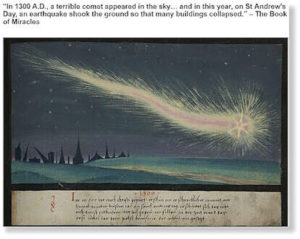
The general theme of this article is that cyclical, cosmic catastrophes have played a major role in the shaping of the history of our planet and its civilizations.
Though there has been a lot of resistance to the idea of catastrophism (probably mostly by the authoritarian-follower-type scientists), a few years ago the Proceedings of the National Academy of Science published a study by an international team of scientists who reached general agreement that a meteorite or comet fragment storm hit the Earth a little more than 12,000 years ago and is likely to have been responsible for the extinction of megafauna and many prehistoric peoples that occurred at that time. It is also now being said that evidence for the extreme heat produced by the equivalent of thousands of overhead nuclear explosions has been found on at least two continents.
The resistance to the very idea of Catastrophism is a bizarre phenomenon. It seems that many so-called scientists react to this subject with as much foaming at the mouth as they exhibit when confronted with evidence for the so-called Paranormal. The experiences of Immanuel Velikovsky are a case in point. (And I won’t be promoting his ideas here, so relax.) Even though he made a number of predictions that later proved to be correct, Velikovsky spent four years trying to be heard in established scientific circles, meeting with total failure. Those who supported him suffered ostracism and academic blackballing. The editor who had handled the publication of his book was dismissed and, under pressure from the scientific establishment, the publication rights were transferred to another publisher. The scientific community worked long and hard to discredit Velikovsky and the Encyclopedia Britannica Yearbook for 1950 does not even mention that Worlds In Collision was a best-seller for that year.
What in the world did Velikovsky say to engender such censorious reactions? Surely if they simply disagreed with him they could write their refutations and allow all to be heard in open forum. Why did they work so hard to silence this book? In the morass of differing scientific opinions, why did this one engender such a near-unanimous outcry of “Foul?”
In his own role as psychiatrist, Dr. Velikovsky analyzed the reactions of the scientific community as being similar to the response of a psychotic who has been told that his problems stem from the repression of desires to rape his mother and kill his father; the patient has erected elaborate defenses against this unbearable truth, and it manifests in disorder which all operate to conceal from him his true desires. And, while he may know that it is the truth, he lashes out in violent fury against the one that has deprived him of his elaborately constructed defenses.
Rephrasing that in the context of our topic here, catastrophism assaults our deepest feelings of security, our prejudices against transformation. Psychologists have constructed charts, which itemize events leading to stress, giving each a point value. Apparently, Cosmic bombardment of our planet is off the scale. A thought such as this affects us deeply even if we are speaking of things, which may have been experienced in ages past. “We want to feel that our homes rest on solid foundations and that the blue sky above us is a benevolent firmament“. “What good is a house,” said Thoreau, “if we haven’t a respectable planet to put it on?” (Note that this fear is being politicized by the Green Movement and their Catastrophic Global Warming/Climate Change program. Climate Change activists are as rabid and terrified as those who attacked Velikovsky.)
Modern theories of geology, paleontology, archaeology, biology, cosmology, and so forth, are all expressed in Darwinian terms which state that change takes place slowly over eons, aided by gradual processes of natural selection, erosion, etc. James Hutton, founder of the modern view, expressed it: “No powers are to be employed that are not natural to the globe, no action to be admitted of except those of which we know the principle.” It is a doctrine that was long taken for granted within the scientific community. “If nature were not uniform, then one could not use the results of one experiment to predict the outcome of the next; neither could one assume that laws founded on a thousand varied observations would remain true. Without uniformity in nature, doing physics, chemistry, and biology would be like traveling in Alice’s Wonderland. Logic, science, and life itself would fall to pieces.”
To suggest that this idea of slow and orderly process is, in its basic assumption, totally wrong, is a threat of the most disruptive event in the history of science. The dismissal of this as “truth” would eclipse the furor, which surrounded the denial of the earth as the center of the universe. As long as it was accepted that the sun travelled around the earth, all other ancient errors held up as truth. In the same way, as long as the steady state of the solar system is the asserted dogma, all current scientific assumptions will hang together on this point.
Due to authoritarian personalities seeking to please wealthy elite authorities who need to retain their control over society, science changes its ideas very, very slowly and the truly gifted and original researchers are either worn out from being attacked and defending themselves, or dead, by the time the consensus changes. This is very bad for science and very bad for humanity.
So, getting on: First let me mention the work of dendrochronologist/ paleoecologist, Mike Baillie (now retired) of Queens university, Belfast, Ireland. (Baillie is a leading expert in dendrochronology, or dating by means of tree-rings. In the 1980s, he was instrumental in building a year-by-year chronology of tree-ring growth reaching 7,400 years into the past.) Examining tree rings, Baillie found climate stress periods in 2354 BCE, 1628 BCE, 1159 BCE, 208 BCE, and CE 540. The evidence suggested that these were probably global events to one extent or the other.
The CE 540 event coincides with the second-largest ammonium signal in the Greenland ice in the past two millennia, the largest signal showing in 1014 CE. Baillie explains the lack of historical references being due to the fact that the peoples of the time described what they saw in Biblical terms. Indeed, there were artistic representations of astonishing atmospheric events, but it was almost always explained as being a metaphor for a Biblical concept! There was also the problem that the Aristotelian view of the ‘perfect heavens’ held sway, and even if events were witnessed and reported, they were explained away or ignored in historical accounts.
Dr. Baillie began to search through historical records and myth. He found that the environmental downturns coincided with the collapse of civilizations, such as the roman empire and the beginning of the dark ages in Europe. He wrote Exodus to Arthur: Catastrophic Encounters with Comets (Batsford (1999)), which relates his tree-ring/ice-core data to a series of global traumas over the past 4,400 years, events that may relate to the Biblical Exodus and dark ages in Egypt, China and Europe.
A later book by Baillie, The Celtic Gods: Comets in Irish Mythology (Baillie & McCafferty (2005)). focused on the CE 540 event which was recorded in the historical records and myths of Ireland. Baillie argues that the mythical imagery and the periodicity of the events are consistent with an Earth-crossing comet that has fragmented such as 2P/Enke, as described by astronomers Victor Clube and Bill Napier (who we will get to shortly). Baillie’s latest book, New Light on the Black Death: The Cosmic Connection (Baillie (2006)), marshals the considerable evidence that the Black death (1346-1350) was due to a series of comet related disasters.
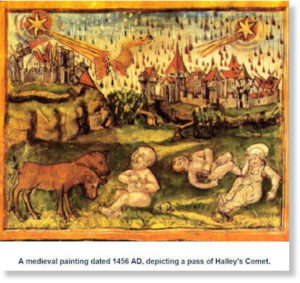
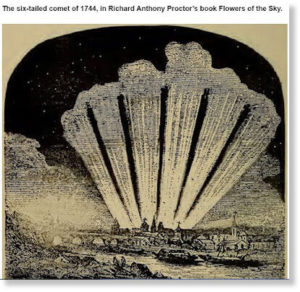
Next, along came the work of physicist, Richard Firestone and geologists, Alan West and Simon Warwick-smith, presented in a series of academic papers and a book for the general public: The Cycle of Cosmic Catastrophes: How a Stone Age Comet Changed the Course of World Culture.(2006) They dealt with the – until then – inexplicable mass extinctions of mega-fauna that occurred simultaneously with the onset of the Younger Dryas mini-ice age (c. 13,000 years ago).
However, long before Baillie and Firestone et al, in 1990, Victor Clube, an astrophysicist, and Bill Napier, an astronomer, published The Cosmic Winter, a book in which they describe performing orbital analyses of several of the meteor showers that hit earth every year. using sophisticated computer software, They carefully looked backward for thousands of years, tracing the orbits of comets, asteroids, and meteor showers until they uncovered something astounding. Many meteor showers are related to one another, such as the Taurids, Perseids, Piscids, and Orionids. In addition, some very large cosmic objects are related: the comets Encke and Rudnicki, the asteroids Oljato, Hephaistos, and about 100 others. Every one of those 100- plus cosmic bodies is at least a half-mile in diameter and some are miles wide. And what do they have in common? According to those scientists, every one is the offspring of the same massive comet that first entered our system less than 20,000 years ago! Clube and Napier calculated that, to account for all the debris they found strewn throughout our solar system, the original comet had to have been enormous.
Clube and Napier also calculated that, because of subtle changes in the orbits of Earth and the remaining cosmic debris, Earth crosses through the densest part of the giant comet clouds about every 2,000 to 4,000 years. When we look at climate and ice-core records, we can see that pattern. For example, the iridium, helium-3, nitrate, ammonium, and other key measurements seem to rise and fall in tandem, producing noticeable peaks around 18,000, 16,000, 13,000, 9,000, 5,000, and 2,000 years ago. In that pattern of peaks every 2,000 to 4,000 years, we may be seeing the “calling cards” of the returning megacomet.
Fortunately, the oldest peaks were the heaviest bombardments, and events have been getting quieter since then, as the remains of the comet break up into even smaller pieces. The danger is not past, however. Some of the remaining miles-wide pieces are big enough to do serious damage to our cities, climate, and global economy. Clube and Napier (1984) predicted that, in the year 2000 and continuing for 400 years, Earth would enter another dangerous time in which the planet’s changing orbit would bring us into a potential collision course with the densest parts of the clouds containing some very large debris. Twenty years after their prediction, we have just now moved into the danger zone. it is a widely accepted fact that some of those large objects are in Earth-crossing orbits at this very moment, and the only uncertainty is whether they will miss us, as is most likely, or whether they will crash into some part of our planet.(Firestone et al. (2006), pp. 354-355.)
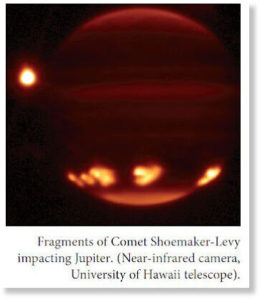
According to Baillie, Clube and Napier, et al., in the same way that Jupiter was struck repeatedly in 1994 by the million-megaton impacts of the comet shoemaker-Levy, so Earth was bombarded 13,000 years ago by the fragments of a giant comet that broke up in the sky before the terrified eyes of humanity. The multiple impacts on the rotating planet caused tidal waves, raging fires, atomic bomb-like blasts, the mass extinction of many prehistoric species such as the mammoth and sabre-toothed tiger, most of humanity, and left the world in darkness for months if not years.
It was this event that left the hundreds of thousands of Carolina Bays, the millions of dead creatures – most of them megafauna – piled up in jumbled masses around the globe, and would also have wiped the earth almost clean of any existing human civilization. (This bottleneck is evident in genetic studies.) What Baillie, Clube and Napier propose, in addition to the scenario proposed by Firestone et al., is that our planet has been struck numerous times since then (and maybe even before that major event), and it isn’t over.
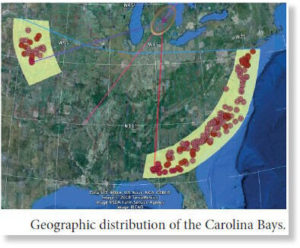
This ‘new’ type of natural disaster is beginning to be regarded by many scholars as the most probable single explanation for widespread and simultaneous cultural collapses at various times in our history. These ideas have been advanced largely by practitioners of hard science – astronomers and geologists, dendrochronologists, etc. – and remain almost completely unknown (or completely misunderstood) among practitioners of the soft sciences: archaeologists and historians. This fact significantly hampers the efforts of practitioners of the soft sciences to explain what they may be seeing in the historical record.
A recent example, known as the Tunguska event, occurred over Siberia in 1908 when a bolide exploded about 5 km above ground and completely devastated an area of some 2,000 km² through fireball blasts. While it is still a matter of controversy among researchers, this cosmic body is thought to have measured some 60 m across (some say 190 m across) and had the impact energy of about 20 to 40 megatons (some say 3-5 megatons), equivalent to the explosion of about 2,000 (or at least several hundred) Hiroshima size nuclear bombs, even though there was no actual physical impact on the Earth. In other words, if there were ancient, advanced civilizations destroyed by multiple Tunguska-like events (remember the hundreds of thousands of Carolina Bays?), it would be no wonder there is no trace, or very little, and what evidence does exist, such as the bays, are usually ascribed to ‘anomaly’ or ignored altogether.

Baillie, Clube and Napier identified the progenitor of the Taurid complex as a giant comet that was thrown into a short-period (about 3.3 year) orbit, some time in the last twenty to thirty thousand years. The Taurid complex currently includes the Taurid meteor stream, Comet Encke, ‘asteroids’ such as Comet 2101 Adonis and 2201 Oljato, and enormous amounts of space dust sorted along the orbit in clumps that may include rather larger bodies. Asteroids in the Taurid complex appear to have associated meteor showers, which means that many asteroids are likely to be extinct comets. In other words, there can be more than just some dust and snow in a comet – there can be a significant rocky core and lots of poisonous gasses and chemicals as well. But, of course, having a 3.3 year orbit does not necessarily mean that every 3.3 years there will be disasters; there is rather more involved in bringing the Earth into the right position when the Earth-crossing bodies are present. This view of the solar system gave me a whole different view of the ancient myths that I had been trying to sort out as possibly historical actions of human beings that had been mythicized by the Greeks and then re-historicized by the Hebrews.
For years, the astronomical mainstream was highly critical of Baillie, Clube and Napier and their giant comet hypothesis. however, the impacts of Comet Shoemaker-Levy 9 on Jupiter in 1994 led to a rather rapid turnaround in attitude, at least among curious and open scientists.
Read the second part of the article
Author: Laura Knight-Jadczyk
yogaesoteric
September 18, 2023
